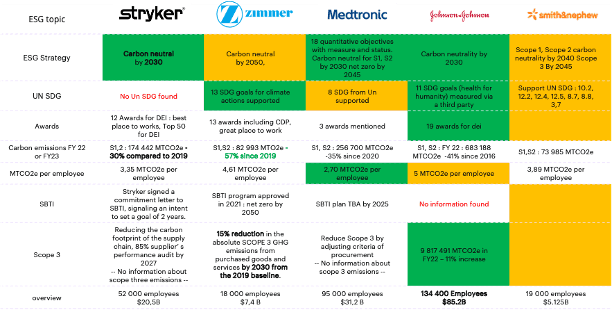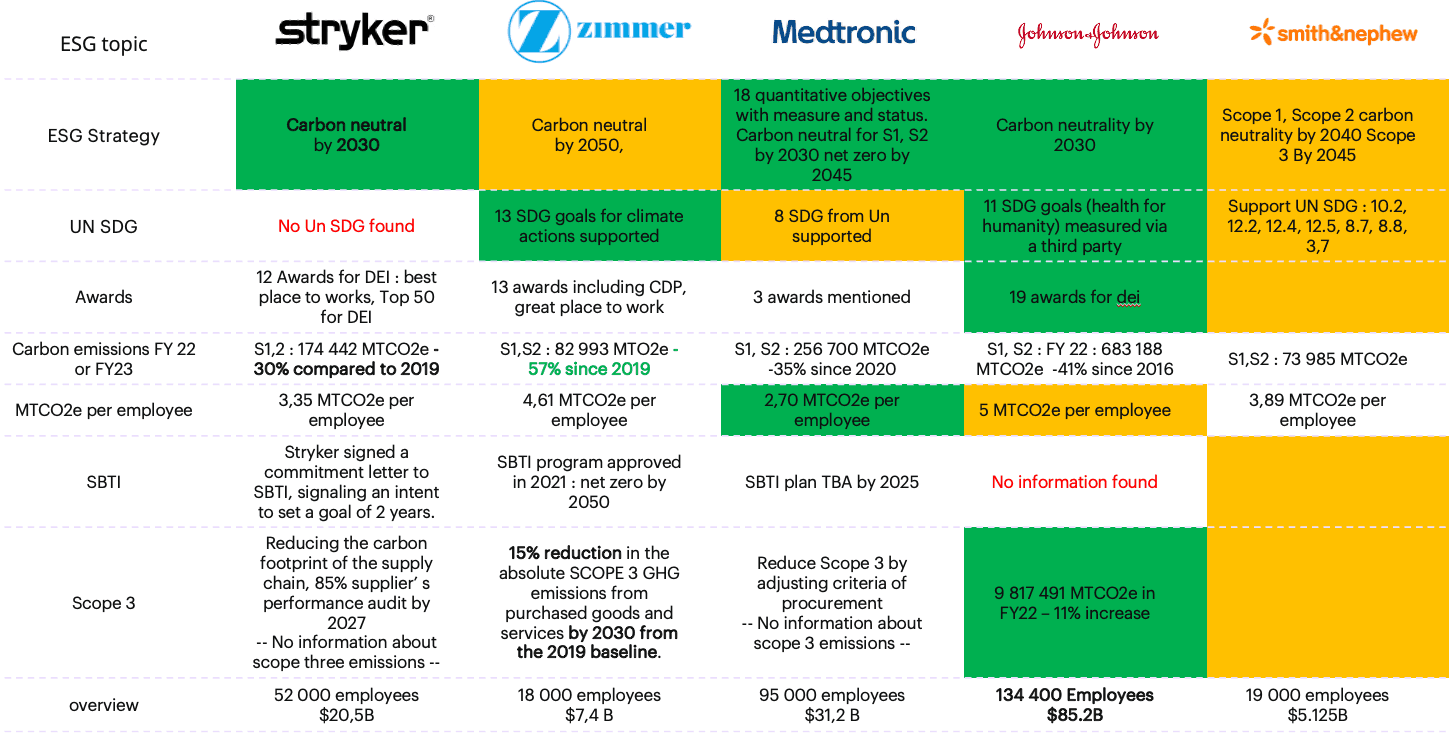ESG performance in the Medtech sector: How industry leaders are shaping sustainability in 2023
Oct 29, 2024
ESG performance in the Medtech sector: How industry leaders are shaping sustainability in 2023
In 2023, medtech industry leaders are making ESG a competitive asset by improving the sustainability of supply chains and fostering innovation for a sustainable health future.
ESG Performance in the Medtech Sector: How Industry Leaders are Shaping Sustainability in 2023
Environmental, social, and governance (ESG) issues have become essential for the medtech sector in recent years. As medical device companies respond to increasing regulatory requirements and stakeholder expectations, the need to balance sustainability and medical innovation has never been more crucial. This article examines the key ESG issues facing the MedTech sector in 2023, focusing on how leading companies are addressing their environmental impact, sustainability practices, and governance frameworks.

What are the main ESG issues for the Medtech sector?
The medtech sector faces numerous ESG challenges, including the environmental impact of manufacturing, supply chain sustainability, and governance issues. Here is a detailed overview of these areas :
Environmental Impact of Medical Device Manufacturing
Companies like Stryker and Medtronic have set ambitious carbon neutrality targets, with Stryker aiming for 2030. Their commitment reflects a global shift in the industry to minimize greenhouse gas (GHG) emissions and optimize energy efficiency.
Sustainability of Supply Chains and Sourcing Challenges
Our analysis shows that Medtronic and Zimmer are tackling their Scope 3 emissions by engaging their suppliers and investing in high-energy efficiency technologies. Given the scale of emissions related to global supply chains, these efforts are crucial.
Governance Issues in the Healthcare Sector
Increased transparency in ESG reporting and adherence to governance standards help medtech companies build trust with stakeholders. For instance, Johnson & Johnson considers governance to be an essential aspect of its ESG strategy.
How are Medtech companies addressing their carbon footprint?
Many medtech companies are committed to reducing their carbon footprint by focusing on energy efficiency, waste reduction, and sustainable sourcing.
Greenhouse Gas Emission Reduction Strategies
Zimmer is committed to reducing GHG emissions by 15% in certain high-emission regions by 2030, positioning itself as a leader in climate action.
Improving Energy Efficiency in Medical Technology Production
Several companies are investing in green technologies to reduce their operational energy consumption. For example, Smith & Nephew aims for carbon neutrality for Scope 1 and Scope 2 emissions by 2040, demonstrating a comprehensive approach to sustainability.
Managing Scope 3 Emissions in the Medtech Value Chain
Scope 3 emissions, often the largest portion of a company’s carbon footprint, are a focal point for many firms. Johnson & Johnson reported significant Scope 3 emissions for 2022, illustrating the magnitude of indirect emissions in their value chain.
What ESG initiatives are leading Medtech companies implementing?
Medtech companies are adopting various ESG initiatives to reduce their environmental impact, increase transparency, and meet stakeholder expectations.
Sustainability Programs in Medical Device Design and Production
Companies such as Stryker are rethinking device design to incorporate sustainable materials, reduce waste, and improve recyclability.
Waste Management and Reduction of Single-use Devices
Medtronic, among others, has launched programs to address the problem of single-use device waste, a major environmental concern for the medtech sector. Their efforts aim to limit unnecessary waste and promote recycling.
Transparency and Stakeholder Engagement in ESG Reporting
Transparency in ESG reporting enables companies to demonstrate their accountability. Medtronic’s commitment to annual sustainability reports illustrates a strong stakeholder engagement strategy.
How does ESG performance impact competitiveness in the Medtech sector?
ESG performance is increasingly seen as a competitive advantage, driving innovation, meeting regulatory standards, and attracting investors.
ESG as a Driver of Innovation and Digital Health Solutions
Digital health solutions offer new ways for MedTech companies to reduce emissions and improve patient outcomes, aligning with ESG goals.
Meeting Regulatory Requirements and ESG Standards
As regulations tighten, companies must ensure compliance to avoid penalties and maintain market access. Johnson & Johnson’s alignment with recognized ESG standards demonstrates the regulatory importance of strong ESG credibility.
Attracting Investors and Partners through Strong ESG Credentials
Investors are increasingly examining ESG metrics. Companies that improve their sustainability practices attract investors concerned about ESG issues, thus stimulating growth and innovation.
What are the challenges in measuring and improving ESG performance for Medtech companies?
Despite the progress, the medtech sector faces challenges in balancing ESG goals with the unique demands of the industry, such as improving patient care and producing diagnostic equipment.
Balancing ESG Goals with Advances in Medical Technology
While ESG goals are essential, medtech companies must prioritize patient outcomes. Stryker, for example, strives to reconcile environmental responsibility with the need for high-performing medical devices.
Reducing the Environmental Impact of Diagnostic Equipment
The production of diagnostic tools involves substantial resource use, posing a challenge for sustainability. Johnson & Johnson’s commitment to assessing and minimizing environmental impacts illustrates a proactive approach in the industry.
Aligning ESG Initiatives with Patient Care Priorities
Medtech companies align their ESG initiatives with patient care goals, recognizing that health outcomes and environmental protection can be complementary.
How are Medtech leaders setting ESG targets for 2030 and beyond?
Industry leaders are setting ambitious ESG targets, committing to net-zero emissions and other long-term sustainability goals.
Commitments to Net Zero Emissions and Emission Reduction Strategies
Medtronic has announced a commitment to the Science-Based Targets Initiative (SBTi), aiming for carbon neutrality by 2040, while Stryker aims for 2030.
Long-term Sustainability Goals in the Healthcare Sector
Companies are increasingly setting long-term sustainability goals that go beyond emission reduction, including waste reduction, water conservation, and sustainable sourcing.
Integrating ESG into Business Strategy and Governance
The integration of ESG principles into Zimmer’s corporate governance illustrates how medtech companies align ESG with broader business strategies.
What best practices are emerging for ESG in the global Medtech sector?
Leading medtech companies are setting benchmarks for ESG practices, from R&D to collaborations with healthcare providers.
Integrating ESG Considerations into Research and Development
Johnson & Johnson integrates ESG into product development, seeking to minimize environmental impacts from the design phase.
Collaborating with Healthcare Providers on Sustainability Initiatives
Partnerships with healthcare providers are essential for promoting sustainable practices throughout the value chain, with companies like Medtronic at the forefront.
Utilizing Digital Health Solutions to Enhance ESG Performance
The adoption of digital health solutions, including telemedicine and AI, can significantly reduce the environmental footprint of medtech services.
Conclusion
The medtech sector's commitment to ESG is transforming how companies operate and innovate. From ambitious carbon neutrality targets to advanced waste management programs, medtech leaders are shaping a sustainable future. Looking towards 2030 and beyond, ESG will remain at the heart of the medtech sector, providing a competitive advantage and fostering resilience in an ever-evolving healthcare landscape.
Sign up for the Newsletter








